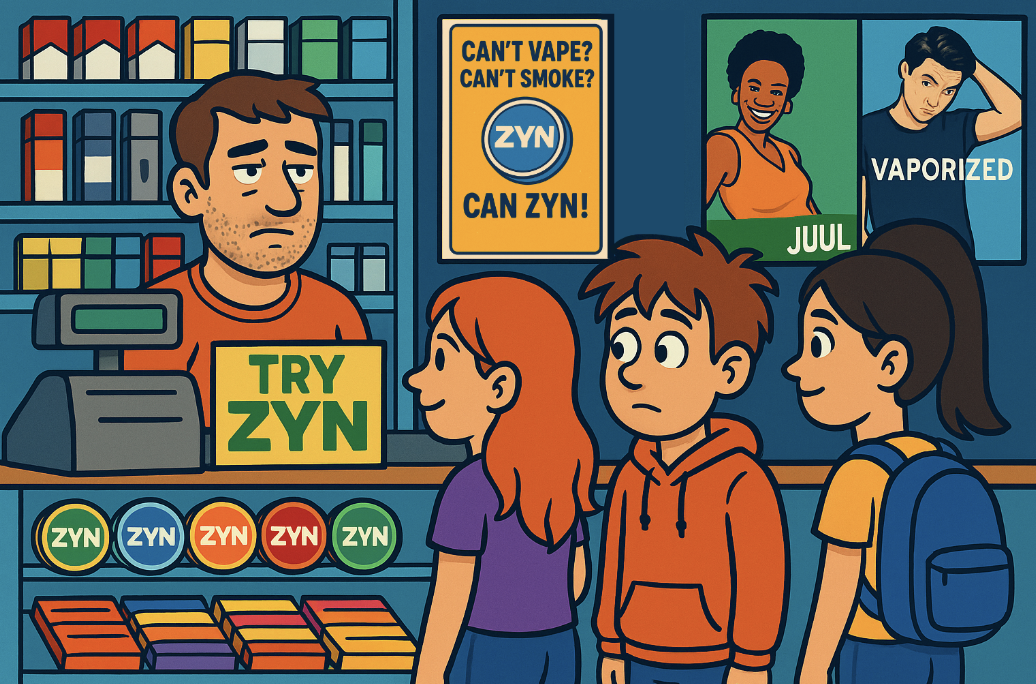JUUL Walked So ZYN Could Slide Into Your Feed
Like JUUL before it, ZYN is using influencers, slick branding, and social media to reach young people where they scroll, glossing over risk with influencers and aesthetics.
ZYN isn’t just a nicotine pouch. It’s Big Tobacco’s latest rebrand.
Scroll through social media or tune into a podcast, and there it is: influencers casually name-dropping ZYN, “ZYNfluencers” reviewing flavors like citrus, wintergreen, and coffee. The product is popping up across platforms, sometimes mentioned offhand, sometimes featured as part of a trend, blurring the line between cultural reference and marketing. With sleek packaging and viral appeal, ZYN is positioning itself as a lifestyle brand: clean, cool, and consequence-free.
One of their taglines says it all: “Can’t smoke. Can’t vape. Can ZYN.” It nods to young people navigating smoke-free policies, school rules, and public awareness. But the message is clear. When other forms of nicotine are off-limits, ZYN presents itself as the loophole. No smoke, no device, no visible cloud, just a discreet little pouch you can pop in your mouth and keep moving. That’s the hook.
But make no mistake. Behind the hashtags is the same industry that once marketed “light” cigarettes and flavored vapes. The packaging may be new, but the goal is the same: keep people hooked using the same deceptive strategies they’ve relied on for decades.
What Is a ZYN?
ZYNs are smokeless, flavored nicotine pouches placed between the gum and lip. They come in small, colorful tins that look more like Icebreakers gum than a drug… and that’s the point.
Here’s what many young people don’t realize:
ZYNs contain concentrated doses of nicotine, up to 6 mg per pouch, which can be especially potent for teens or first-time users.
Nicotine can raise blood pressure and heart rate, increasing the risk of cardiovascular problems like heart disease.
It’s linked to oral health issues, including gum disease, recession, and tooth decay.
Some recent studies have raised concerns about the presence of harmful chemicals, including potential carcinogens, though more research is needed.
It’s nicotine, rebranded: no smoke, no smell, but the same addictive substance, marketed as a “healthier” option. Sound familiar?
History Repeating Itself
Big Tobacco’s playbook hasn’t changed. It just updates the packaging. For decades, the industry has rebranded nicotine as “safer” while hiding the risks.
1950s–60s: Deny and Distract
When smoking was linked to cancer, companies launched PR campaigns to deny harm and sow doubt.1970s–80s: Filtered, Light, and Low-Nicotine Lies
Marketed as healthier, these products encouraged deeper inhalation and didn’t reduce addiction.1990s: “Nicotine Isn’t Addictive”
Executives denied nicotine’s addictiveness under oath, despite internal evidence to the contrary.2000s–2010s: The Vape Pivot
As smoking declined, companies pushed sleek, flavored e-cigs like JUUL, packaged as harm reduction.2020s: Synthetic Nicotine and Pouches
ZYN hits the market: smokeless, odorless, and framed as a workaround. But it’s the same substance, the same risk, and the same strategy.
ZYN is just the latest in a long line of products designed to look safe, feel trendy, and get users hooked — and once again, teens are in the crosshairs.
Nicotine and the Teen Brain: Risk, Addiction, and Mental Health
Research indicates that nicotine products like ZYN, especially when used during adolescence, can prime the brain for lifelong addiction. Nicotine affects regions responsible for memory, judgment, and impulse control—functions that are still developing in teens.
Even if ZYN seems safer than smoking, the notion that it offers a risk-free alternative is a dangerous myth. The earlier a young person starts using nicotine, the higher their chances of developing dependence and progressing to other substances later on.
Nicotine use in adolescence is also linked to increased symptoms of anxiety and depression. According to the CDC, the most common reason students give for currently using e-cigarettes is feeling anxious, stressed, or depressed. Nicotine addiction or withdrawal can contribute to these feelings or exacerbate them, leading to a cycle of dependence.
Furthermore, the National Institute on Drug Abuse (NIDA) reports that youth who use tobacco products are more likely to experience mental health issues, including mood disorders.
Rather than alleviating stress or improving focus, nicotine can disrupt brain chemistry and worsen mood regulation over time.
What Works: Calling Out the Lie
History shows that one of the most effective prevention tools isn’t just listing health risks—it’s exposing the lie. During the height of the anti-smoking movement, what changed teen behavior wasn’t just pictures of black lungs. It was the realization that they were being manipulated.
That’s what we need now.
How to Bring This Into the Classroom
The good news? Young people don’t like being lied to. When they understand how these products are marketed—through influencers, podcasts, and branding—it clicks. They start to ask questions. They start to see through the hype. Here's how to help them get there:
Teach Media Literacy
Break down how nicotine is advertised online. Help students spot how influencers and brands normalize use and build loyalty.Draw the Historical Line
Use a timeline to connect the dots—from cigarettes to JUUL to ZYN—and show how the strategy hasn’t changed.Focus on Brain Science
Explain how nicotine hijacks the adolescent brain, especially around decision-making and risk.Name the Industry Tactics
Ask: Why label a product “tobacco-free” if it still contains addictive nicotine? Who profits from the confusion?Empower with Truth
The goal isn’t just to say “don’t do it.” It’s to help students recognize the manipulation and make informed choices.
Bottom Line: ZYN Is Big Tobacco
Don’t be fooled by the packaging. ZYN is just the next chapter in a decades-long effort to sell addiction as cool. Like menthols before it, like JUUL, it’s a familiar strategy in new wrapping. With influencers, algorithms, and podcast sponsors in the mix, the marketing is more sophisticated than ever.
Our job is to pull back the curtain. When young people see the playbook for what it is, they’re more likely to opt out.

